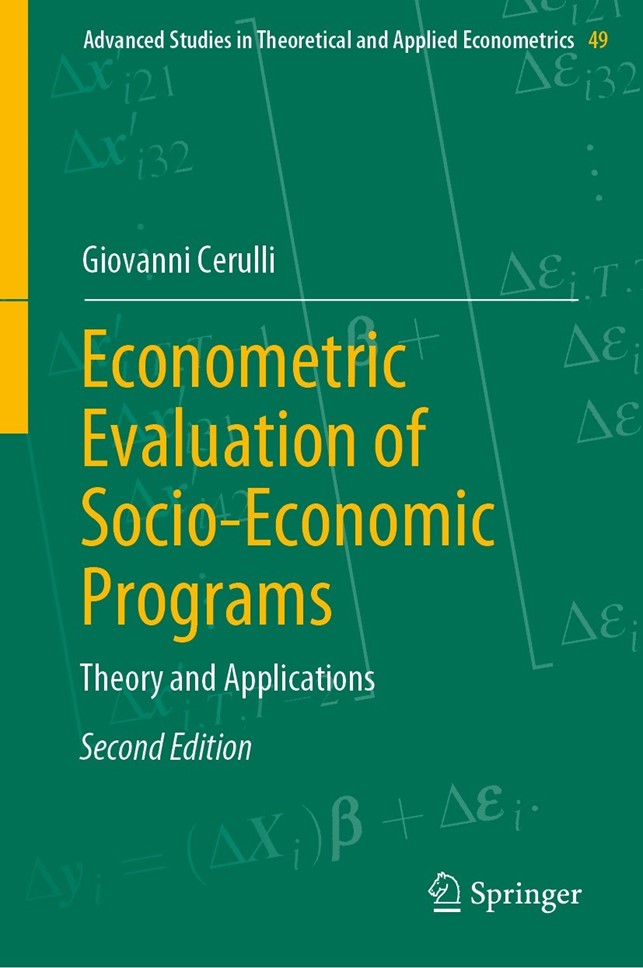Econometric Evaluation of Socio-Economic Programs by Giovanni provides advanced theoretical and applied tools for the implementation of modern micro-econometric techniques in evidence-based program evaluation for the social sciences. The author presents a comprehensive toolbox for designing rigorous and effective ex-post program evaluation using the statistical software package Stata. For each method, a statistical presentation is developed, followed by a practical estimation of the treatment effects. By using both real and simulated data, readers will become familiar with evaluation techniques, such as regression-adjustment, matching, difference-in-differences, instrumental-variables, regression-discontinuity-design, and synthetic control method, and are given practical guidelines for selecting and applying suitable methods for specific policy contexts.
The second revised and extended edition features two new chapters on some recent development of difference-in-differences. Specifically, chapter 5 introduces advanced difference-in-differences methods when many times are available and treatment can be either time-varying or fixed at a specific time. Chapter 6 introduces the synthetic control method, a treatment effect estimation approach suitable when only one unit is treated. Both chapters present applications using the software Stata.
AN INTRODUCTION TO THE ECONOMETRICS OF PROGRAM EVALUATION
Introduction
Statistical Setup, Notation, and Assumptions
Identification Under Random Assignment
A Bayesian Interpretation of ATE Under Randomization
Consequences of Nonrandom Assignment and Selection Bias
Selection on Observables and Selection on Unobservables
Selection on Observables (or Overt Bias) and Conditional Independence Assumption
Selection on Unobservables (or Hidden Bias)
The Overlap Assumption
Characterizing Selection Bias
Decomposing Selection Bias
The Rationale for Choosing the Variables to Control for
Partial Identification of ATEs: The Bounding Approach
A Guiding Taxonomy of the Econometric Methods for Program Evaluation
Policy Framework and the Statistical Design for Counterfactual Evaluation
Available Econometric Software
A Brief Outline of the Book
References
METHODS BASED ON SELECTION ON OBSERVABLES
Introduction
Regression-Adjustment
Regression-Adjustment as Unifying Approach Under Observable Selection
Linear Parametric Regression-Adjustment: The Control-Function Regression
Nonlinear Parametric Regression-Adjustment
Nonparametric and Semi-parametric Regression-Adjustment
Matching
Covariates and Propensity-Score Matching
Identification of ATEs Under Matching
Large Sample Properties of Matching Estimator(s)
Common Support
Exact Matching and the “Dimensionality Problem”
The Properties of the Propensity-Score
Quasi-exact Matching Using the Propensity-Score
Methods for Propensity-Score Matching
Inference for Matching Methods
Assessing the Reliability of CMI by Sensitivity Analysis
Assessing Overlap
Coarsened-Exact Matching
Reweighting
Reweighting and Weighted Least Squares
Reweighting on the Propensity-Score Inverse-Probability
Sample Estimation and Standard Errors for ATEs
Doubly-Robust Estimation
Implementation and Application of Regression-Adjustment
Implementation and Application of Matching
Covariates Matching
Propensity-Score Matching
An Example of Coarsened-Exact Matching Using cem
Implementation and Application of Reweighting
The Stata Routine treatrew
The Relation Between treatrew and Stata’s teffects ipw
An Application of the Doubly-Robust Estimator
References
METHODS BASED ON SELECTION ON UNOBSERVABLES
Introduction
Instrumental-Variables
IV Solution to Hidden Bias
IV Estimation of ATEs
IV with Observable and Unobservable Heterogeneities
Problems with IV Estimation
Selection-Model
Characterizing OLS Bias within a Selection-Model
A Technical Exposition of the Selection-Model
Selection-Model with a Binary Outcome
Difference-in-Differences
DID with Repeated Cross Sections
DID with Panel Data
DID with Matching
Implementation and Application of IV and Selection-Model
The Stata Command ivtreatreg
A Monte Carlo Experiment
An Application to Determine the Effect of Education on Fertility
Applying the Selection-Model Using etregress
Implementation and Application of DID
DID with Repeated Cross Sections
DID Application with Panel Data
References
LOCAL AVERAGE TREATMENT EFFECT AND REGRESSION-DISCONTINUITY-DESIGN
Introduction
Local Average Treatment Effect
Randomization Under Imperfect Compliance
Wald Estimator and LATE
LATE Estimation
Estimating Average Response for Compliers
Characterizing Compliers
LATE with Multiple Instruments and Multiple Treatment
Regression-Discontinuity-Design
Sharp RDD
Fuzzy RDD
The Choice of the Bandwidth and Polynomial Order
Accounting for Additional Covariates
Testing RDD Reliability
A Protocol for Practical Implementation of RDD
Application and Implementation
An Application of LATE
An Application of RDD by Simulation
An application of RRD to real Data
References
DIFFERENCE-IN-DIFFERENCE WITH MANY PRE- AND POST-TREATMENT TIMES
Introduction
The TVDIFF Model
Testing the “Common Trend” Assumption
An Application of the TVDIFF Model
The TFDIFF Model
Generalization to More Than Three Times
Testing the Parallel-Trend Assumption
An Application of the TFDIFF Model
Parallel-Trend Test in the Presence of Effect Anticipation
Conclusion
References
SYNTHETIC CONTROL METHOD
Introduction
The SCM Model
SCM Inference
Application
Conclusions
References


